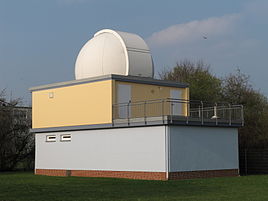Hondelage
|
Hondelage
City of Braunschweig
|
|
|---|---|
| Coordinates: 52 ° 18 ′ 52 ″ N , 10 ° 36 ′ 15 ″ E | |
| Height : | 75 m above sea level NN |
| Residents : | 3673 (December 31, 2015) |
| Incorporation : | March 1, 1974 |
| Postal code : | 38108 |
| Area code : | 05309 |
|
Location of Hondelage in Braunschweig
|
|
|
Observatory
|
|
Hondelage is a district and part of the city of Braunschweig . The city district has the official number 113. Since the regional reform on March 1, 1974, Hondelage has been incorporated into Braunschweig. It is north of Autobahn 2 from Hanover to Berlin . On the outskirts, the Hagenriede flows into the Schunter , a tributary of the Oker .
Together with the Wabe-Schunter-Beberbach and Volkmarode districts , Hondelage forms the electoral district 11.
Mayor, from March 1974 local mayor, today district mayor, is Berndt Schulze
history
The place was first mentioned in 1179 as a Honloge, i.e. an altitude, an open area in the surrounding forests. A castle of the same name was built and a ministerial family (the Lords of Honlage ) was appointed to administer and defend the area. Only a few ruins of the castle still exist on the banks of the Schunter; the castle tower became a church tower after the nave of today's Protestant Church of St. John was added. Many of the castle's stones can still be found today in the foundations of the oldest farms in the village.
To the north of today's town is the Hegerdorf desert (original name: Hegerdorp). The artisan village was abandoned about 500 years ago. The podium of the former Hegerdorp chapel can still be seen with the naked eye.
The population of Hondelage was purely rural in the Middle Ages with around 30 farms, even if craftsmen and small businesses were added from the 16th century. In the course of the Reformation a school was established; Even today, the place is purely Protestant ( Lutheran ) and has a large elementary school, which, in addition to the parish and sports club, is a social center in the place.
After the population had remained constant at around 500 for a long time, that changed to over 1000 with the influx of refugees after 1945. Another wave of immigration came with the movement to the suburbs and the countryside in the late 1960s and early 1970s, the population rose from around 2000 to over 5000 within a few years. With the incorporation to Braunschweig on March 1, 1974, growth slowed down again, even if the infrastructure and the service sector continued to improve.
The motorway exit Braunschweig-Ost (A2 / 57) can be reached via the neighboring towns Lehr-Wendhausen and Dibbesdorf , the motorway exit Braunschweig-Flughafen (A2 / 56) is direct. The Braunschweig Airport is located west-northwest of Hondelage in the neighboring Waggum .
Today's place is determined by an active community and club life. There is a small observatory run by amateur astronomers with a 50 cm reflector telescope . There is a small industrial area in the village, which is of national importance due to the chimney construction and lightning protection companies. Lightning protection systems for Moscow-Sheremetyevo Airport at the end of the 1970s and for the power stations in Timbuktu in Mali were planned and set up from Hondelage.
Two ichthyosaurs were found in the clay slate and marl pit of Hondelage in September 2011 after a skeleton of a steneosaurus had been discovered in the 1950s .
Religions
The historic St. John's Church has modern facilities (Johannesweg 1). The parish today belongs to the Evangelical Lutheran Propstei Braunschweig .
The Catholic Don Bosco house with chapel was consecrated in 1986 (Hegerdorfstraße 46). It was created by converting a former Haake-Beck brewery branch. Originally a branch of the parish of St. Martin in Lehrer-Wendhausen , it has belonged to the parish of St. Marien in Braunschweig-Querum since a parish merger in 2006 . In the parish hall there is next to the chapel the kindergarten of a non-denominational parents' initiative and the group room for the Catholic scouts .
coat of arms
The coat of arms shows on a red shield two silver lilies crossed diagonally, which are arranged over a silver star with six points.
It is the former family coat of arms of those "von Honlage", who verifiably carried it from 1226 to their extinction in 1510. They once owned the whole village, but in 1384 they sold half of it to Riddagshausen monastery . From 1483 they also pledged the other half to the monastery and finally gave it all over to it in 1510. Who designed the coat of arms is unknown.
This coat of arms was officially selected on October 26, 1978 by a resolution of the local council.
literature
- Gerhard Bothe: Chronicle of the village of Hondelage. Municipality of Hondelage, Hondelage 1975, DNB 770531741 .
- R. Petras, H. Völker: 800 Years of Hondelage. Working group 800-year celebration of Hondelage, DNB 820021164 .
Web links
- Hondelage website at hondelage.info
- City of Braunschweig: District Advisory Board Hondelage on braunschweig.de
- Sights of Hondelage on braunschweig.de
- Entry by Stefan Eismann on Hondelage in the scientific database " EBIDAT " of the European Castle Institute
Individual evidence
- ↑ Population statistics on braunschweig.de
- ↑ Dinosaur bones discovered - after 50 years of search ( Memento from December 24, 2014 in the Internet Archive )
- ^ Arnold Rabbow: New Braunschweigisches Wappenbuch. Braunschweiger Zeitungsverlag, Meyer Verlag, Braunschweig 2003, ISBN 3-926701-59-5 , p. 24.





